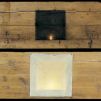CACT E-STUDIO
Christos Bokoros’ painting is extremely representational and plausible, usually practiced on familiar genuine surfaces such as wood and cloth, and momentarily disturbs the balance of our perception of the visible reality; it reveals a bit of our primordial existence, lingering between the true essence of being and the supernatural dimension. Among the most recognizable elements that characterize and run through the overall of his creation lie his superior technique, his remarkable skill and the flawless representational accuracy of his paintings. A powerful solidarity prevails in his work in his attempt to seek and reveal a spiritual context by means of a modern perspective and a poetic approach. In the core of his work lies the true nature of painting seen as a standpoint and philosophy on life, as a purifying act, as an interaction with the “mystical” and “inconceivable”, as an existential issue, and as a premise of completeness and determination.
He initially depicts everyday objects, interior spaces and human figures; he employs the technique of frontal composition, carefully measured and balanced, characterized by plain drawings and detailed method, by a quiet discreet and restrained color palette, by sensitivity and ease on depicting the detailed drifting of tones. Thus, Bokoros accomplishes outstanding aesthetical results defining an initial and extremely interesting stage of “apprentiship in reality”.
In the course of his artistic evolution, his compositions become classified into several categories according to their theme and reveal before us a whole world of symbols; Bokoros refers to everything that he senses beyond the commonly visible. In 1991 he presents OA/Eggs, while later on with his work Beds he emphasizes on the parameters of time and language, and contemplates the existential anguish of man, the anxiety of death, and the metaphor-allegory of the eternal circle of life. In the Parable of the olive tree, his artistic language reaches its peak in terms of maturity, sophistication and culmination. He sets up a composite scenery-intervention in an approach that leads further than painting itself, and offers a comprehensive series which includes the monumental painting of a tree (The tree), the clay statue of a naked man (The man) and the wooden, archaic temple-like construction with the half-open doors, within which a flame shimmers in the dark (The house). Painting and conceptual elements, ethnographic, geographic, historical and cultural references coexist in an artistic environment of several mediums and are integrated in a common axis. Bokoros intends to narrate a story in the form of a parable, to speak of timelessness and continuity, experiences, the individual and the collective.
In the series Offerings (1997), the concept of preserving memory, the being and not being, the coexistence of the living and the deceased, signal the notional boundaries. His artworks convey holiness and his enchanting practice intensifies the suggestive-mystical atmosphere resulting in a refined and decipherable symbolism that effortlessly emerges. During the 90’s and afterwards as well, his works are characterized by individual and collective memories that touch upon mythology and legend. His themes make reference and are deeply related to tradition; they are symbolically expanded in space and time in his attempt to commune with the “common daemon” of the land, to express his profound emotional ties to the past, to identify himself as a member of a community and thus to be self-defined as well. In the late 90’s, the series The inner light –one of his most inspired series– attests his ability to elaborate demanding and complicated themes such as the capture of light in compositions strongly related to the inner world. These compositions refer to something higher, offer aesthetical charm while invoking the spiritual and ineffable, effortlessly unfold their mystery and magic, harmonically combine the visible and invisible, the material and non-material. His work Uncommended Forest / Viniani (2004) is a bold painting environment, a silent and abstract scenery, rich in content and connotations, that touches upon a subject which still bleeds, hurts, and burdens conscience; a subject that has not preoccupied many Greek artists yet. The background of these compositions consists of grief and lament, of redemption and catharsis for those who remained anonymous and for those who were defeated(?) during the civil war. Bokoros’ oeuvre stands beyond identifications, classifications and integrations, beyond art issues such as representational techniques, postmodernism, nationality, and identity. His artistic creation implies deeper primal values, sets aside the contemporary, evokes eternity in everyday life, and demands more than the obvious; it longs to be “a miraculous human epiphany, a soulful luminous body”.












